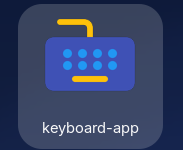In this post, I will be announcing the new features and the existing struggles of my keyboard app.
The Recap
Let’s recap about “what does this app solve?” Onscreen keyboard app that uses English (UK/US) keyboard inputs to map to various languages.
The New Features
New languages support such as German, Italian, Lao, Vietnamese. And a bug fix regarding language specific fonts, this adjusts the natural font based on language choice. I was quite fascinated how easy it was to add Vietnamese. Lao required me to evaluate font choices but I liked how similar feel was to Thai Abugida. The Abugida composition was beautifully handled by the font.
The Struggles
The languages that made me struggle the most are Greek, Tibetan, and Korean. Making the total supported languages count 6.
Greek characters were straightforward; they didn’t require additional fonts. However, there is a specific diaeresis/dialytika mark that launches a different layout. I couldn’t find a solution to launch a third layout since my program supports a maximum of two layouts per language.
Tibetan requires a specific font like Lao and Thai, which contributes to the growing bundle size. The size is negligible; however, Tibetan has more than four layouts, which requires an algorithm change to all layouts to perform “shift” key functionality on different keys. This breaks the two-layouts-per-language rule in my app. But I have seen these patterns in languages like Greek, so I may need to address this in the near future to support more languages. Furthermore, Tibetan composition is completely handled by the font so I am lucky with the embedded fonts.
Korean comes with its Hangul composition complexity. I initially thought Hangul composition was handled by the fonts like in Thai, Lao, or other Indic Abugidas. It turns out Hangul composition is handled by the IME (Input Method Editor of the specific OS), and Tauri seems to be missing that layer. Re-writing Hangul composition is relatively hard and requires derivations of existing methods in my project, and I am no expert in that area. There were third-party libraries such as khangul; however, it requires creating another input state in its context, which requires me to juggle two different input states between language choices which is not cool for maintainability of my project.
The interesting part I discovered was implementing NOOP buttons for Korean. It seems that Korean Hangul is really running out of characters when the “shift” key is used. They have no CAPS LOCK and fewer SHIFT variant keys, so some keys had to implement NOOP. This was quite a different experience. Overall, I expected Korean fonts to resolve the need for re-writing Hangul composition, but they didn’t, so I am disappointed with the way Korean (Hangul) characters work in composition. To add salt to the injury, undoing characters is extremely complex with my own Hangul composition API or third-party Hangul composition API.
Final Words
Checkout the releases for v0.2.0
If you are Arch Linux user, Pauron bot got you covered here. Please upvote it! ;)
Found a bug? Spotted an issue? Have a brilliant idea to share? Don’t hesitate to give me a nudge!
